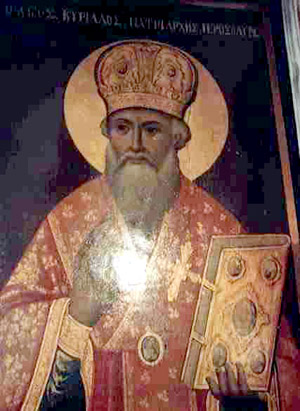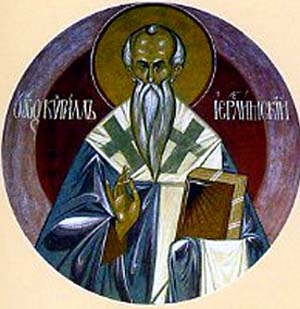 |
The Saint of the Day
St. Cyril of Jerusalem – March 18
Prof. Plinio Corrêa de Oliveira
Biographical selection:
Cyril was born in Jerusalem in 315. From his youth he dedicated himself to the study of the Holy Scriptures and acquired a great knowledge of Church doctrine by reading the Fathers who came before him. When St. Maximus died, Cyril succeeded him in the See of Jerusalem in 349.

St. Cyril suffered three exiles from his see of Jerusalem
|
At the beginning of his episcopacy, he became famous for a dispute with Acacius, Archbishop of Caesarea, an ardent follower of Arianism who abhorred Cyril and his orthodoxy. Because of the plots of Acacius, he was exiled twice from Jerusalem. But after Julian the Apostate was raised to the throne of the Empire, a general amnesty was granted for Prelates who had been exiled; therefore, he entered the city and re-assumed his see.
From there, he witnessed the miraculous obstacles sent by God that made it impossible to rebuild the Temple of Jerusalem. Julian, who took the side of the Jews against the Catholics, tried to rebuild the Temple two times. The first time the recently laid foundation was destroyed by an earthquake; the second time the groundwork was destroyed by flames of fire that burst forth from the ground. During these attempts of reconstruction, St. Cyril calmly affirmed that the prophecy of Christ would remain true, and that not one stone of the Temple would be left standing upon another.
He was exiled for a third time when Emperor Valens, a follower of Arianism, decreed the expulsion of all Prelates recalled by Julian. Under Theodosius, he returned from this exile to find his flock torn by heresies and schisms. He made great efforts to achieve doctrinal unity and peace.
In 381 he took part in the Council of Constantinople and signed the condemnation of semi-Arianism. He died in 386. His great work, The Catecheses, or Catechetical Lectures, is turned toward the preparation of catechumens and neophytes.
Comments of Prof. Plinio:
Parallel to Bishops who were founders of nations, like St. Patrick, whose life we have already commented on [click here], there were also Bishops whom we can call pillars of the Church. They existed primarily in the East, and St. Cyril of Jerusalem was one of them.
When the Church left the Catacombs, many of her members were contaminated by a spirit of tepidness and spiritual decadence that propitiated the infiltration of paganism into Catholic milieus. It was a subtle penetration that stimulated them to accept diverse heresies. It was an attempt of the Devil to make them shake off the easy yoke of Our Lord placed by Constantine over the entire Empire.

St. Cyril was one of the heroic Bishops of the East who left a legacy to build the Middle Age
|
In the West heresies popped up, one more harmful than the other, until the fall of the Roman Empire. In the East those heresies would continue. Such heresies, however, gave rise to numerous heroic and saintly Bishops who fought like lions against them. These heroes often ended by being defeated, but they filled the Church with splendor. They wrote works; they took positions that later would be admired and serve as a base to build the magnificent edifice of the Middle Ages.
Considering the example of St. Cyril of Jerusalem and so many other Saints, we understand what the fight for the Church should be. One must fight expending all his strength and resources. At times, he will die in the battle without fully realizing the effect of his effort, for often only the immediate defeat is apparent. But afterwards, that effort is remembered and treasured by others as a precious legacy, and it gives great fruits.
The Fathers and the Doctors of the Church – St. Cyril is one of them – played an enormous role in setting the foundations for Scholasticism and establishing the Catholic State in the Middle Ages. They were received with ingratitude by their contemporaries, but they formed the basis for the great triumph of Catholic Civilization.
From such examples, we can understand that we should fight for the cause of the Church by assuming a similar state of spirit that can appear paradoxical:
First, we must fight with the certainty that we are defeating the Revolution, which will fall under the blows we are giving it. We feel an appeal of Divine Providence calling us to do this and a promise that Our Lady wants to use us to accomplish this work.
Second, we must have such a great dedication to this fight that, even if we were to die without having defeated the Revolution and seeing the Reign of Mary, we would close our eyes in peace knowing that our effort will have an effect.
Third, even if this effort were not to have any effect in the future and would never be known to future generations, even if it would be lost in anonymity, we should be at peace because we will know that in the Book of Life, our fight was written for the Day of Judgment. It will be recognized that at the moment in History when Our Lady was prisoner there were a few who came to fight for her. In a world where truth was no longer welcome, there were some who proclaimed it. In this epoch of darkness, there were some who glorified God.
Therefore, our fight - which is motivated by these three certainties - is always a work that gives fruit. And if it is an incessant, indomitable fight in which we use every legitimate means, it will be an invincible one.
Let us pray to the great St. Cyril of Jerusalem to obtain for us the spirit of Faith he showed and left as an example so that we might destroy the Revolution in our days.


  | | Prof. Plinio Corrêa de Oliveira | |
The Saint of the Day features highlights from the lives of saints based on comments made by the late Prof. Plinio Corrêa de Oliveira. Following the example of St. John Bosco who used to make similar talks for the boys of his College, each evening it was Prof. Plinio’s custom to make a short commentary on the lives of the next day’s saint in a meeting for youth in order to encourage them in the practice of virtue and love for the Catholic Church. TIA thought that its readers could profit from these valuable commentaries.
The texts of both the biographical data and the comments come from personal notes taken by Atila S. Guimarães from 1964 to 1995. Given the fact that the source is a personal notebook, it is possible that at times the biographic notes transcribed here will not rigorously follow the original text read by Prof. Plinio. The commentaries have also been adapted and translated for TIA’s site.
|
Saint of the Day | Home | Books | CDs | Search | Contact Us | Donate

© 2002- Tradition in Action, Inc. All Rights Reserved
|
 |

|